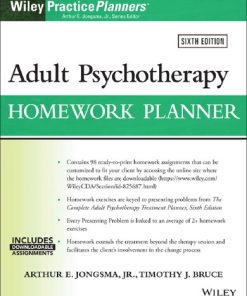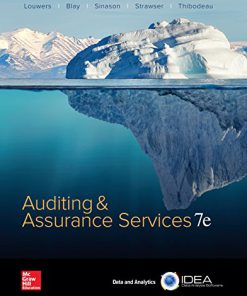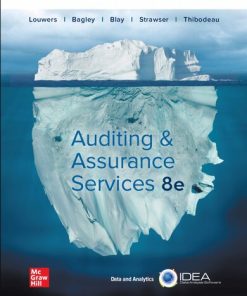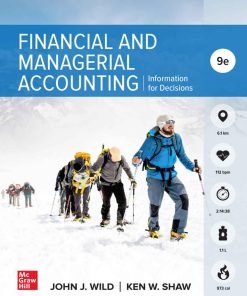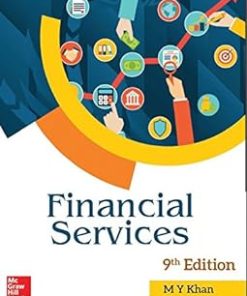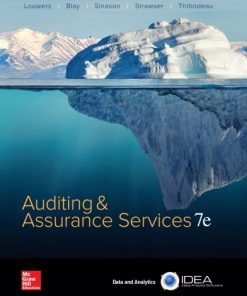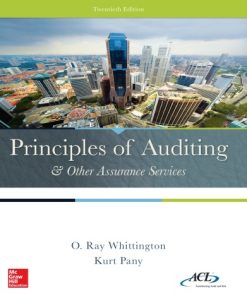AUDITING and ASSURANCE SERVICES 9th Edition by Timothy Louwers 1266847929 9781266847929
$50.00 Original price was: $50.00.$25.00Current price is: $25.00.
AUDITING and ASSURANCE SERVICES 9th Edition by Timothy J. Louwers – Ebook PDF Instant Download/DeliveryISBN: 1266847929, 9781266847929
Full download AUDITING and ASSURANCE SERVICES 9th Edition after payment.
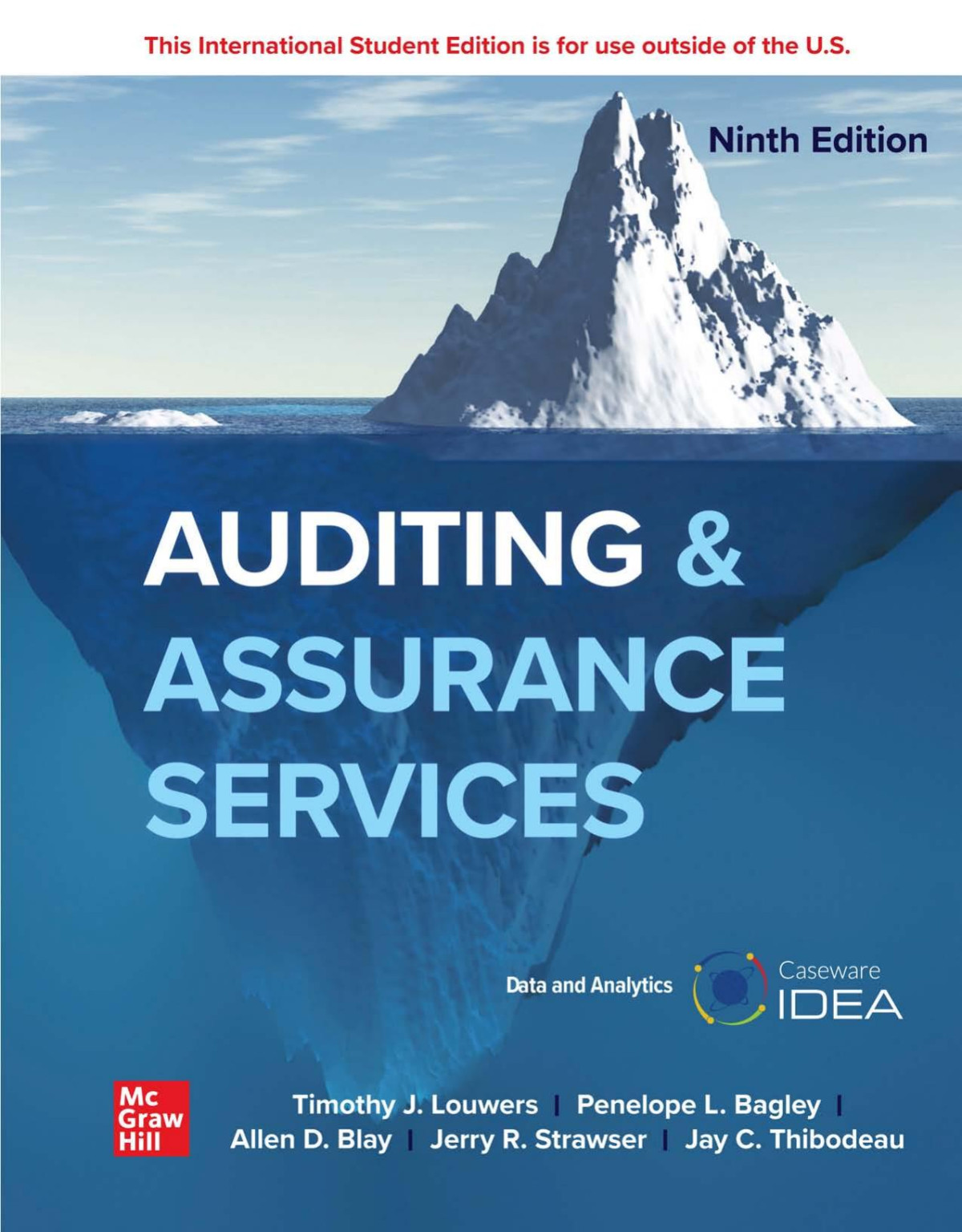
Product details:
ISBN-10 : 1266847929
ISBN-13 : 9781266847929
Author: Timothy J. Louwers
As auditors, we are trained to investigate beyond appearances to determine the underlying facts—in other words, to look beneath the surface. Whether evaluating the Enron and World-Com scandals of the early 2000s, the financial crisis of 2007–2008, the Wirecard fraud in 2020 or present-day issues and challenges related to significant estimation uncertainty, understanding the auditor’s responsibility related to fraud, maintaining a clear perspective, probing for details, and understanding the big picture are indispensable to effective auditing. With the availability of greater levels of qualitative and quantitative information (“Big Data”), the need for technical skills and challenges facing today’s auditor is greater than ever. The Louwers, Bagley, Blay, Strawser, and Thibodeau team has dedicated years of experience in the auditing field to this new edition of Auditing & Assurance Services, supplying the necessary investigative tools for future auditors.
AUDITING and ASSURANCE SERVICES 9th Table of contents:
Part I: The Contemporary Auditing Environment
Part II: The Financial Statement Audit
Part III: Stand-Alone Modules
Acknowledgments
OUR SINCEREST THANKS. . .
A SPECIAL RECOGNITION
Connect Feature
Instructors
Students
Brief Contents
Contents
Chapter 1: Auditing and Assurance Services
Professional Standards and Learning Objectives
User Demand for Reliable Information
Information Risk in a Big Data World
Auditing, Attestation, and Assurance Services
Assurance Services
Examples of Assurance Services
Attestation Engagements
Financial Statement Auditing
Auditing in a Big Data Environment
Management’s Financial Statement Assertions
Existence or Occurrence (Existence, Occurrence, Cutoff)
Completeness (Completeness, Cutoff)
Valuation and Allocation (Accuracy, Valuation, and Allocation)
Rights and Obligations (Rights and Obligations)
Presentation and Disclosure (Classification, Presentation)
Importance of Assertions
Professional Skepticism
Public Accounting
Auditing and Assurance Services
Tax Services
Advisory Services
Other Kinds of Engagements and Information Professionals
Internal Auditing
Governmental Auditing
Regulatory Auditors
Become a Professional and Get Certified!
Education
Examination
Experience
State Certificate and License
Skill Sets and Your Education
Summary
Key Terms
Multiple-Choice Questions for Practice and Review
Exercises and Problems
Apollo Shoes
Chapter 2: Professional Standards
Professional Standards and Learning Objectives
Introduction
Generally Accepted Auditing Standards (GAAS)
Organization of GAAS
Fundamental Principle: Responsibilities
Competence and Capabilities
Independence and Due Care
Professional Skepticism and Professional Judgment
Fundamental Principle: Performance
Planning and Supervision
Materiality
Risk Assessment
Audit Evidence
Fundamental Principle: Reporting
Evaluating the Quality of Public Accounting Firms’ Practices
System of Quality Control12
PCAOB Inspection of Firms
Summary
Key Terms
Multiple-Choice Questions for Practice and Review
Exercises and Problems
Appendix 2A
EXAMPLE: AUDITING REPORTING
EXAMPLE: AUDIT CONFIRMATIONS
Chapter 3: Engagement Planning and Audit Evidence
Professional Standards and Learning Objectives
Introduction
Pre-Engagement Activities
Client Acceptance or Continuance
Compliance with Independence and Ethical Requirements
Engagement Letters
Audit Plan
Staffing the Audit Engagement
Time Budget
Materiality
Materiality Calculation
Other Issues that Impact Materiality
How Auditors Use Materiality
Audit Procedures for Obtaining Audit Evidence
1. Inspection of Records and Documents
2. Inspection of Tangible Assets
3. Observation
4. Inquiry
5. Confirmation
6. Recalculation
7. Reperformance
8. Analytical Procedures
Audit Documentation
Permanent Files
Current Files
Audit Documentation Arrangement and Indexing
Summary
Key Terms
Multiple-Choice Questions for Practice and Review
Exercises and Problems
Apollo Planning
Audit Planning Part Two
Chapter 4: The Audit Risk Model and Inherent Risk Assessment
Professional Standards and Learning Objectives
Introduction
Audit Risk
Audit Risk
Inherent Risk
Control Risk
Detection Risk
Audit Risk Model
Fraud Risk
Fraud
Types of Fraud
Inherent Risk Assessment—“What Could Go Wrong?”
Understanding the Client’s Business and Its Environment
Gathering Information and Preliminary Analytical Procedures
General Business Sources
Company Sources
Information from Client Acceptance or Continuance Evaluation, Audit Planning, Past Audits, and Other Engagements
Preliminary Analytical Procedures
Audit Team Brainstorming Discussions
Inquiry of Audit Committee, Management, and Others within the Company
Overall Assessment and Documentation of Inherent Risk Assessment
Required Documentation
Other Considerations
Audit Strategy Memorandum
Summary
Key Terms
Multiple-Choice Questions for Practice and Review
Exercises and Problems
Apollo Shoes Preliminary Analytical Procedures
Preliminary Analytical Procedures
Apollo Shoes Audit Risk Model
Audit Risk Model
Appendix 4A
Appendix 4B
OVERVIEW
PRODUCT PRICING
GOVERNMENT INFLUENCES
CUSTOMERS, SUPPLIERS, AND COMPETITORS
RISK ASSESSMENT
REVENUE AND COLLECTION CYCLE
AUDIT APPROACH
Chapter 5: Risk Assessment: Internal Control Evaluation
Professional Standards and Learning Objectives
Introduction
Definition of Internal Control
Internal Control Effectiveness
Limitations of Internal Control
Management versus Auditors’ Responsibility for Internal Control
Management’s Internal Control Responsibilities
Auditors’ Internal Control Responsibilities
Components of Internal Control
Control Environment
Risk Assessment
Control Activities
Information and Communication
Monitoring
Internal Control Evaluation
Phase 1: Understand and Document the Client’s Internal Control System
Phase 2: Assessment of Control Risk
Phase 3: Identify Controls to Test and Perform Tests of Controls
Internal Control Communications
Summary
Key Terms
Multiple-Choice Questions for Practice and Review
Exercises and Problems
Apollo Shoes
Internal Control Testing
Appendix 5A
Chapter 6: Employee Fraud and the Audit of Cash
Professional Standards and Learning Objectives
Introduction
The Need for Skepticism in Audits of Cash
Employee Fraud Overview
Employee Fraud Red Flags
Characteristics of Fraudsters
The Fraud Triangle
Incentive/Pressure
Opportunity
Attitude/Rationalization
Fraud Prevention
Managing People and Pressures in the Workplace
Internal Control Activities and Employee Monitoring
Tone at the Top
The Audit of Cash
Management Reports and Data Files in an Audit of Cash
Significant Accounts and Relevant Assertions
Risk of Material Misstatement
Evaluating the Design and Operating Effectiveness of Internal Controls
Substantive Procedures
“Extended Procedures” to Detect Fraud
Summary
Key Terms
Multiple-Choice Questions for Practice and Review
Exercises and Problems
Apollo Shoes Cash Audit
Audit of the Cash Account
Appendix 6A
Appendix 6B
Chapter 7: Revenue And Collection Cycle
Professional Standards and Learning Objectives
Introduction
Revenue and Collection Cycle: Typical Activities
Receiving and Processing Customer Orders, Including Credit Granting ①
Delivering Goods and Services to Customers ②
Billing Customers and Accounting for Accounts Receivable ③
System-Generated Reports and Data Files in the Revenue and Collection Cycle
Significant Accounts and Relevant Assertions
Risk of Material Misstatement
Revenue Recognition
Collectability of Accounts Receivable
Customer Returns and Allowances
Internal Control Activities and Design Evaluation
Entity-Level Controls in the Revenue and Collections Cycle
Control Considerations at the Account and Assertion Level
Tests of Operating Effectiveness of Internal Control
Summary: Control Risk Assessment
Substantive Analytical Procedures and Tests of Details
Analytical Procedures
Confirmation of Accounts and Notes Receivable
Alternative Procedures
Additional Notes about Confirmations
Dual-Purpose Nature of Accounts Receivable Confirmations
Review for Collectability
Cutoff and Sales Returns
Audit Risk Model Applied
Application in the Field
Audit Cases: Extended Audit Procedures
Summary
Key Terms
Multiple-Choice Questions for Practice and Review
Exercises and Problems
Apollo Shoes Accounts Receivable Audit
Accounts Receivable Audit
Appendix 7A
Appendix 7B
Chapter 8: Acquisition And Expenditure Cycle
Professional Standards and Learning Objectives
Introduction
Acquisition and Expenditure Cycle: Typical Activities
Purchasing Goods and Services ①
Receiving the Goods or Services ②
Recording the Asset or Expense and Related Liability ③
Significant Accounts and Relevant Assertions
Accounts Payable
Expenses
Risk of Material Misstatement
Internal Control Activities and Design Evaluation
Entity-Level Controls
Control Considerations
Custody
Periodic Reconciliation
Testing of Operating Effectiveness of Internal Control
Tests of Controls
Substantive Analytical Procedures and Tests of Details
Accounts Payable and the Completeness Assertion
Other Expenditure Cycle Accounts
Presentation and Disclosure
Audit Risk Model Applied
Fraud Cases: Extended Audit Procedures (Isa/As 2301)
Summary
Key Terms
Multiple-Choice Questions for Practice and Review
Exercises and Problems
Apollo Shoes Audit of Liabilities
Audit of Liabilities
Appendix 8A
Appendix 8B
Appendix 8C
The Payroll Cycle: Typical Activities
Significant Accounts and Relevant Assertions
Internal Control Activities and Evaluation
Substantive Analytical Procedures and Tests of Details
FRAUD CASE: EXTENDED AUDIT PROCEDURES
Multiple-Choice Questions for Practice and Review
Exercises and Problems
Apollo Shoes Payroll Audit
Payroll Audit
Chapter 9: The Production Cycle and Auditing Inventory
Professional Standards and Learning Objectives
Keeping Count
Inventory Management: Typical Activities
Significant Accounts And Relevant Assertions
Risk of Material Misstatement
Internal Control Activities and Design Evaluation
Testing of Operating Effectiveness of Internal Control
Substantive Analytical Procedures and Tests of DetailS
Difficult Inventory Circumstances
Audit Risk Model Applied
Fraud Case: Extended Audit Procedures
Summary
Key Terms
Multiple-Choice Questions for Practice and Review
Exercises and Problems
Apollo Shoes Inventory Audit
Inventory Audit
Appendix 9A
Appendix 9B
Chapter 10: Finance And Investment Cycle
Professional Standards References
Introduction
Finance and Investment Cycle: Typical Activities
Financing the Entity Through Debt and Stockholder Equity
Financial Planning ①
Raising Capital ②
Investing Transactions: Investments and Intangibles ③
Significant Accounts and Relevant Assertions
Risk of Material Misstatement
Complex Transactions
Fair Market Value
Related-Party Transactions
Lease Accounting
Loan Covenants
Impairments
Presentation and Disclosure
Internal Control Activities and Design Evaluation
Control Considerations
Tests of Operating Effectiveness of Internal Control
Control over Accounting Estimates
Authorization
Record Keeping
Custody
Summary: Control Risk Assessment
Substantive Analytical Procedures and Tests of Details
Investment Securities
Long-Term Liabilities and Related Accounts
Stockholders’ Equity
Fraud Cases: Extended Audit Procedures (As 2301)
Summary
Key Terms
Multiple-Choice Questions for Practice and Review
Exercises and Problems
Appendix 10A
Appendix 10B
Chapter 11: Completing The Audit
Professional Standards and Learning Objectives
Introduction
Audit Timeline
Procedures Performed during Fieldwork
Completing Substantive Procedures
Attorney Letters
Written Representations
Ability to Continue as a Going Concern
Adjusting Entries and Financial Statement Disclosure
Audit Documentation Review
Subsequent Events and Subsequently Discovered Facts
Subsequent Events
Subsequently Discovered Facts
Responsibilities Following the Audit Report Release Date
Omitted Procedures
Communications with Individuals Charged with Governance
Management Letter
Summary of Audit Communications
Summary
Key Terms
Multiple-Choice Questions for Practice and Review
Exercises, Problems, and Simulations
Apollo Shoes Completing the Audit
Completing the Audit
Chapter 12: Reports On Audited Financial Statements
Professional Standards and Learning Objectives
Introduction
Overview of Auditors’ Reports
The Standard Report for Nonissuers
Types of Opinions
Conditions That Require Modifications to the Auditors’ Standard (Unmodified) Report
Departures from GAAP4
Scope Limitations
Audits of Group Financial Statements
Audits of Group Financial Statements
Auditors’ Reports Referencing Other Matters Encountered during the Audit
Consistency
“Going-Concern” Uncertainties
Other Information Included in Annual Reports
Supplementary Information
Other Modifications
Summary: Emphasis-of-Matter and Other-Matter Paragraphs
Comparative Financial Statements
Same Auditors, Same Opinions for Comparative Years
Same Auditors, Different Opinions for Comparative Years
Same Auditors with Modification of Previously Issued Opinion
Different Auditors in Comparative Years
Other Reporting Topics
Special Purpose Frameworks
Summary Financial Statements
Specified Elements, Accounts, or Items
Compliance with Contractual Agreements or Regulatory Requirements
Disclaimers of Opinion
Summary
Key Terms
Multiple-Choice Questions for Practice and Review
Exercises and Problems
Appendix 12A Auditors’ Reports for Issuers (Public Entities)
AUDITORS’ REPORTS FOR ISSUERS (PUBLIC ENTITIES)
Appendix 12A Exercises and Problems
Chapter 12: Reports On Audited Financial Statements MC/Exercises & Problems
Multiple Choice PCAOB
Exercises and Problems PCAOB
Chapter 12: Reports On Audited Financial Statements (PCAOB Version)
Professional Standards and Learning Objectives
Introduction
Overview of Auditors’ Reports
The Standard Reportfor Issuers
Types of Opinions
Conditions That Require Modifications to the Auditors’ Standard Report
Departures from GAAP
Scope Limitations
Audits of Group Financial Statements
Audits of Group Financial Statements
Auditors’ Reports Referencing Other Matters Encountered During the Audit
Consistency
“Going-Concern” Uncertainties
Other Information Included with Financial Statements
Supplementary Information
Other Modifications
Summary: Explanatory Paragraphs
Other Reporting Topics
Comparative Financial Statements
Condensed Financial Statements
Disclaimers of Opinion
Summary
Key Terms
Multiple-Choice Questions for Practice and Review
Exercises and Problems PCAOB
Module A: Other Public Accounting Services
Professional Standards and Learning Objectives
Introduction
Introduction to Attestation Engagements
Attestation Engagements
Service Organization Control (SOC) Engagements
Agreed-Upon Procedures Engagements
Prospective Financial Information
Compliance Attestation
Broker–Dealer Compliance
Other Attestation Engagements and Summary
Accounting and Review Services for Historical Financial Information
Review Engagements
Compilation Engagements
Preparation Engagements
Summary of Engagements on Historical Financial Information
Assurance Services
Scope of Assurance Services
Trust Services
The Future of Assurance Services
Summary
Key Terms
Multiple-Choice Questions for Practice and Review
Exercises and Problems
Module B: Professional Ethics
Professional Standards and Learning Objectives
Introduction
An Ethical Decision Process
Making Ethical Decisions
Philosophical Principles in Ethics
The Imperative Principle
The Principle of Utilitarianism
The Generalization Argument
Virtue Ethics
Ethical Codes of Conduct
U.S. Securities and Exchange Commission (SEC)
The Public Company Accounting Oversight Board (PCAOB)
The International Federation of Accountants (IFAC)
The Professional Ethics Executive Committee (PEEC) of the American Institute of CPAs (AICPA)
An Emphasis on Independence
American Institute of Certified Public Accountants
SEC and PCAOB Independence Rules
Other Effects of Sarbanes–Oxley on Auditor Independence
Government Accountability Office (GAO) Independence Requirements
AICPA Rules of Conduct: Integrity and Objectivity, Responsibilities to Clients, and Other Responsibilities
Integrity and Objectivity Rule
General Standards Rule
Compliance with Standards Rule
Accounting Principles Rule
Acts Discreditable Rule
Fees and Other Types of Remuneration
Advertising and Other Forms of Solicitation Rule
Confidential Client Information Rule
Form of Organization and Name Rule
Consequences of Violating the Code of Professional Conduct
Self-Regulatory Discipline
Public Regulation Discipline
Summary
Key Terms
Multiple-Choice Questions for Practice and Review
Exercises and Problems
Module C: Legal Liability
Professional Standards and Learning Objectives
Introduction
The Legal Environment
Liability Under Common Law
Liability to Clients
Liability to Third Parties
Liability for Compilation and Review Services
Liability Under Statutory Law
The Securities Act of 1933 (Securities Act)
Section 11: Civil Liability
Auditors’ Defenses under the Securities Act
Section 13: Statute of Limitations
Section 17: Antifraud
Section 24: Criminal Liability
The Securities Exchange Act of 1934 (Securities Exchange Act)
Section 10 and Rule 10(b)-5: Antifraud
Section 18: Civil Liability
Auditors’ Defenses under the Securities Exchange Act
Section 32: Criminal Liability
Foreign Corrupt Practices Act (FCPA)
Summary of Auditors’ Liability to Clients and Third Parties
The Changing Landscape of Auditors’ Liability
Sarbanes–Oxley
Racketeer Influenced and Corrupt Organizations Act
Aiding and Abetting
Organization of Accounting Firms as Limited Liability Partnerships
Proportionate Liability
Class-Action Suits
Auditors’ Liability Caps
Other Developments
Summary
Key Terms
Multiple-Choice Questions for Practice and Review
Exercises and Problems
Module D: Internal Audits, Governmental Audits, and Fraud Examinations
Professional Standards and Learning Objectives
Introduction
Internal audits, Governmental Audits, and Fraud Examinations
Internal Audits
Internal Auditing Defined
Internal Audit Standards
Types of Internal Audit Services
Internal Audit Reports
Governmental Audits
Governmental Auditing Defined
Types of Governmental Audits
GAO Government Auditing Standards
GAO Audit Reports
Single Audit Act of 1984 and Amendments of 1996
Fraud Examinations
The Art of Fraud Examinations
Fraud Examiner Responsibilities
Building a Fraud Case
Protecting the Evidence
Obtaining Litigation Support
Summary
Key Terms
Multiple-Choice Questions for Practice and Review
Exercises and Problems
Exercises and Problems Copy
Module E: Attributes Sampling
Professional Standards and Learning Objectives
Introduction
Planning (Steps 1-3)
Step 1: Determine the Objective of Sampling
Step 2: Define the Characteristic of Interest
Step 3: Define the Population
Performing (Steps 4-6)
Step 4: Determine the Sample Size
Step 5: Select the Sample Items
Step 6: Measure the Sample Items
Evaluating Sample Results (Step 7)
Calculating the Upper Limit Rate of Deviation
Making the Evaluation Decision
Using IDEA to Evaluate Sample Results
Qualitative Evaluation of Deviations
Documenting
Other Attributes Sampling Methods
Summary
Key Terms
Multiple-Choice Questions For Practice And Review
Exercises and Problems
Appendix EA
Appendix EB
Module F: Variables Sampling
Professional Standards and Learning Objectives
Introduction
Definition of Variables Sampling
PPS Sampling: Planning
Steps 1–3: Planning
PPS Sampling: Performing
Step 4: Determine the Sample Size
Step 5: Select the Sample Items
Step 6: Measure the Sample Items
Summary: Performing PPS
PPS Sampling: Evaluating
Step 7: Evaluating Sample Results
Other Variables Sampling Approaches
Documentation in Variables Sampling
Summary
Key Terms
Multiple-Choice Questions for Practice and Review
Exercises and Problems
Appendix FA
INTERPOLATING TABLE VALUES IN DETERMINING SAMPLE SIZE
Appendix FB
CLASSICAL VARIABLES SAMPLING
COMPREHENSIVE EXAMPLE: MEAN-PER-UNIT ESTIMATION
PPS VERSUS CLASSICAL VARIABLES SAMPLING
Appendix FB Multiple Choice
Appendix FB Exercises and Problems
Appendix FC
NONSTATISTICAL SAMPLING
Appendix FC Exercises and Problems
Module G Data and Analytics in Auditing:
Professional Standards and Learning Objectives
Introduction
The Art of Discovery
Audit of the Future
Data and Analytics
Common Uses of Audit Data Analytics
Risk Assessment Procedures
Tests of Controls
Substantive Analytical Procedures
Tests of Details
Conducting Audit Data Analytics
Plan the ADA
Access and Prepare the Data
Consider the Relevance and Reliability of the Data
Perform the ADA
Evaluate the Results and Draw Conclusions
Documentation Requirements
Common Tools Used in ADA
Professional Skepticism in ADA
The Next Generation of Auditing
External Big Data
Artificial Intelligence
Distributed Ledger Technology
Summary
Key Terms
Multiple Choice Questions for Practice and Review
Exercises and Problems
Module H: Auditing and Information Technology
Professional Standards and Learning Objectives
Introduction
Automated Transaction Processing
Reliance on IT Controls
Scoping the IT Audit Procedures
Types of IT Control Activities
General IT Controls
Access to Programs and Data Controls
Program Change Controls
Computer Operations Controls
Program Development Controls
Summary
Automated Application Controls
Input Controls
Processing Controls
Output Controls
Summary
Assessing Control Risk in an IT Environment
Testing Controls in an IT Environment
End-User Computing and Other Environments
End-User Computing Control Considerations
Computer Abuse and Computer Fraud
Preventive, Detective, and Damage-Limiting Controls
Computer Forensics
Summary
Key Terms
Multiple-Choice Questions for Practice and Review
Exercises and Problems
Module I
Professional Standards and Learning Objectives
Introduction
Laws and Regulations
Effectiveness of Internal Control
MANAGEMENT’S RESPONSIBILITY
Auditors’ Responsibilities
The Audit of Internal Control Over Financial Reporting
Components of Internal Control over Financial Reporting
Performing The Audit
Audit Planning
Testing Design and Operating Effectiveness
Evaluating Identified Deficiencies
Severity of Deficiency
Compensating Controls
Communicating the Results of the Audit
Communicating Significant Deficiencies and Material Weakness
Audit Reporting
Auditors’ Separate Report on Internal Control Over Financial Reporting
Modifications to the Standard Report
Summary
Key Terms
Multiple Choice Questions For Practice and Review
Exercises and Problems
Apollo Shoes
Auditor’s Report on the Financial Statements and Internal Controls Over Financial Reporting
Cases
Andersen: An Obstruction of Justice?
Andersen: An Obstruction of Justice?
CONCLUSION
DISCUSSION QUESTIONS
PTL Club–The Harbinger of Things to Come?
TROUBLE IN PARADISE
WHERE WAS THE OVERSIGHT?
WHAT DID THE AUDITORS KNOW?
AFTER THE FALL
LAVENTHOL & HORWATH
GOING TO COURT
CONCLUSION
Additional Information
DISCUSSION QUESTIONS
ADDITIONAL SOURCES
GM: Running on Empty?
GM: Running on Empty?
GM’S REORGANIZATION
A BOOST FOR THE AUTO INDUSTRY
EPILOGUE
DISCUSSION QUESTIONS
Unhealthy Accounting at HealthSouth
PROBLEM
AUDIT APPROACH
DISCOVERY
DISCUSSION QUESTIONS
KPMG: How Many Firms?
BACKGROUND
THE PROBLEM
THE OUTCOME
THE ISSUE
EPILOGUE
DISCUSSION QUESTIONS
Something Went Sour at Parmalat
PROBLEM
AUDIT APPROACH
DISCOVERY
DISCUSSION QUESTIONS
GE: How Much Are Auditors Paid?
BACKGROUND
HOW DID SARBANES–OXLEY AFFECT ACCOUNTING FIRM REVENUES?
SEC-REQUIRED FEE DISCLOSURES
GE’S AUDITOR CHANGE
DISCUSSION QUESTIONS
Satyam Computer Services
HISTORY OF SATYAM
INDIAN ACCOUNTING ENVIRONMENT
THE FRAUD
THE AUDITORS
FOLLOW-UP
DISCUSSION QUESTIONS
ADDITIONAL SOURCES
Daily Journal Corporation
REPORTING DELAYS
DISMISSAL OF EY
APPOINTMENT OF BDO USA, LLP
SEC COMMENT LETTER
ANOTHER AUDITOR CHANGE
CONCLUSION
DISCUSSION QUESTIONS
London Has Fallen
DISCUSSION QUESTIONS
Lehman Brothers: Subprime Accounting?
SUBPRIME LENDING
A SOLUTION: INFLATED ASSET VALUATIONS
A LESS TRANSPARENT SOLUTION: REPO 105
WHERE WERE THE AUDITORS?
THE AFTERMATH
DISCUSSION QUESTIONS
ADDITIONAL SOURCES
Bernard L. Madoff: The Fraud of the Century
PONZI SCHEME
SPLIT-STRIKE CONVERSION STRATEGY
SECURITIES AND EXCHANGE COMMISSION
MADOFF’S AUDITOR
DISCUSSION QUESTIONS
When the Music Stops: Crazy Eddie’s
Background
The Hide and Seek of the Audit
Conclusion
Discussion Questions
Sources
Audit Standards
Audit Standards
People also search for AUDITING and ASSURANCE SERVICES 9th:
fundamentals of auditing and assurance services
principles of auditing and assurance services cabrera pdf
principles of auditing and assurance services cabrera answer key
mcgraw hill auditing and assurance services
test bank auditing and assurance services
Tags: AUDITING, ASSURANCE SERVICES, Timothy Louwers, the Enron
You may also like…
Reference - Writing
A Short Guide to Writing about Film 9th Edition Timothy Corrigan
Politics & Philosophy - Social Sciences
The Complete Adult Psychotherapy Treatment Planner 6th Edition
Uncategorized
Auditing & Assurance Services (Auditing and Assurance Services) 7th Edition, (Ebook PDF)
Business & Economics - Accounting
Business & Economics - Accounting
Business & Economics - Accounting
Business & Economics - Accounting
Business & Economics - Accounting





